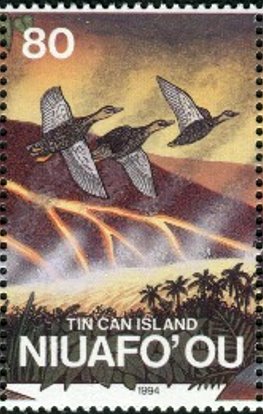Stamp: Indian Spot-billed Duck (Anas poecilorhyncha) (Niuafo'ou 1994)
Indian Spot-billed Duck (Anas poecilorhyncha) (Niuafo'ou 1994)
21 September (Niuafo'ou ) within release Volcanic eruption and evacuation of Niuafo'ou 1946-1958 goes into circulation Stamp Indian Spot-billed Duck (Anas poecilorhyncha) face value 80 Tongan seniti
| Stamp Indian Spot-billed Duck (Anas poecilorhyncha) in catalogues | |
|---|---|
| Michel: | Mi: TO-NI 270 |
Stamp is square format.
Also in the issue Volcanic eruption and evacuation of Niuafo'ou 1946-1958:
- Stamp - Indian Spot-billed Duck (Anas poecilorhyncha) face value 80;
- Stamp - Niaufoou Scrubfowl (Megapodius pritchardii) face value 80;
- Se-tenant - Volcanic eruption and evacuation of Niuafo'ou 1946-1958 face value 5*80;
- Stamp - Blue-crowned Lorikeet (Vini australis) face value 80;
- Stamp - Fleeing inhabitants & White-tailed Tropicbirds face value 80;
- Stamp - Fleeing inhabitants & Great egret face value 80;
Stamp Indian Spot-billed Duck (Anas poecilorhyncha) it reflects the thematic directions:
Birds (Aves), a subgroup of Reptiles, are the last living examples of Dinosaurs. They are a group of endothermic vertebrates, characterised by feathers, toothless beaked jaws, the laying of hard-shelled eggs, a high metabolic rate, a four-chambered heart, and a strong yet lightweight skeleton. Birds live worldwide and range in size from the 5 cm (2 in) bee hummingbird to the 2.75 m (9 ft) ostrich. They rank as the class of tetrapods with the most living species, at approximately ten thousand, with more than half of these being passerines, sometimes known as perching birds. Birds are the closest living relatives of crocodilians.
A volcano is a rupture in the crust of a planetary-mass object, such as Earth, that allows hot lava, volcanic ash, and gases to escape from a magma chamber below the surface. The process that forms volcanoes is called volcanism.


